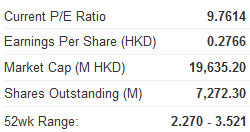
Translated by Andrew Vanburen from 電訊盈科: 分手快樂? by Guni Wudao
TELECOM GIANT PCCW Ltd (HK: 8) is the breakup story that keeps generating breaking news stories.
As most of us know, tycoon Chairman Richard Li’s PCCW hit a major roadblock in its privatization plan three years ago, with a Hong Kong court blocking the conglomerate’s 2.2 bln usd scheme.
But what has happened since to the Hong Kong listco and what can we learn from it?
It is fair at this point to first ask a basic question: Why should we care?
Simply put, the scale of the Hong Kong-based firm is gargantuan, with a strong presence in fixed line, broadband Internet, IPTV, mobile, IT solutions, data centers, integrated global communications, infrastructure, advertising and interactive services.
The group operates nearly 2.6 mln commercial and residential lines, and its IPTV service reaches 40% of the 2.3 mln households in Hong Kong.
It has over 8,000 PCCW Wi-Fi hotspots in the Special Administrative Region (SAR) with enough underground optical fibres in Hong Kong alone to circle the globe 33 times.
Hong Kong Telecom Trust (HKTT; HK: 6823), a late-2011 spin-off telecom asset from the original core of PCCW Ltd, has quickly established itself as the top leading integrated provider of fixed-line phone networks, IDD calling, data and retail broadband, mobile and wireless (2G, 3G., CDMA and Wi-Fi systems) telecom services in Hong Kong.
The spinoff was originally picked up by PCCW Ltd (longform: Pacific Century CyberWorks Ltd) in 2000.

Following HKTT’s spinoff, it went ahead with a fundraising plan, targeting up to 10.7 bln hkd via the issuance of a maximum of 2.36 bln share stapled units (SSU) within an IPO, aiming to become the maiden fixed single investment trust IPO listing in the SAR.
Listing via the business trust platform affords HKTT the luxury of not having to pay dividends based on annual operating cash flow while also not having to cede control of HKT Ltd and disallow HKTT to accumulate debt, via the flotation of SSU.
Complex enough for you? After all, this is the deal that prompted a Hong Kong court to take the somewhat unusual step back in 2009 of stepping in to stop things in their tracks.
Wait, it gets better.
Each SSU is comprised of a single unit of HKTT, a preference share in HKT Ltd (which is in turn stapled to the unit), and what is attractively termed a “beneficial interest” in ordinary shares of HKT Ltd.
Apparently China International Capital Corporation Ltd (CICC), Goldman Sachs and Deutsche Bank have no trouble wrapping their minds around it all because they signed on as joint global sponsors of the IPO, with no word on cornerstone investor participation so far.
And to further complicate matters is PCCW Ltd’s figurative finger being pushed further into the property pie.

Real estate play Pacific Century Premium Developments Ltd (HK: 432) made public around the same time that HKTT was spinning off from PCCW Ltd that 23% stakeholder Elliott Capital requested a sale of PCPD assets, with the sole purpose of tempting the aforementioned Tycoon Li of PCCW fame to repurchase the stock, with the PCCW Ltd chairman currently being the biggest shareholder of PCPD.
I think this ongoing mega-deal exemplifies better than any other current newsmaking corporate restructuring the absolute necessity of fully doing one’s homework before throwing one's investor hat into this shifting ring.
Caveat emptor (buyer beware) is an overused, sometimes hackneyed phrase that often risks losing its meaning through overexposure.
However, it has been around since the Roman Empire so it has withstood the test of time, mainly because it still holds true.
And it should be one of the driving mentalities for investors these days.
See also:
PCCW: Breaking Up Hard To Do?
DMX: Telco Sector Demand Spurred By Technology Replacement
SINOTEL'S PEER IN PRC: GrenTech 2010 Net Triples On WLAN, 3G
電訊盈科: 分手快樂?
(文: 古你唔到)
電訊盈科 (008) 的動作一浪接一浪。繼於上年年尾完成分拆香港電訊信託(6823)之後,目前尚等待向電盈小股東作兩輪實物分派之際,電盈旗下的地產旗艦公司盈科大衍(432),亦在兩周前宣告將股份買賣暫停,待落實股本重組計劃。
電盈主席李澤楷一向被視為精於財技的高手,很多長線的電盈投資者,亦因為電盈自李氏接手以來,長期處於高負債的財務結構下,致價值受壓。不少捧場客因此離場。
直到近兩年,該系公司終於付諸行動,先透過分拆香港電訊信託集資,有助電盈的債務壓力減輕,並且令資產負債表由負變正,重新壯大起來。在財務狀況變得更好時,電盈正是時候去作新一輪部署。
今次的焦點落在盈科大衍,其擬進行回購股份,並且保持上市地位,同時亦擬發行總值2014年到期,總值達24.2億元的可換股票據。坊間報道一般的說法,均指出盈大此舉為將來部署私有化計劃,並且有助減低公眾持股,令將來進行新的企業行動時,減低像過往被基金Elliot力阻私有化般的阻力。

前述說法,自有本身的道理。不過從財務角度分析,或有更新的發現,值得讀者們細味。
事實上,電盈在過去兩年積極部署,將原先資金集中於子公司的情況改變。該集團旗下的盈大,則於2009年底止年度派每股特別股息1.32元,涉總股息31.78億元。此舉令盈太的資產淨值由09年度的89億元,降至2011年上半年度的77億元。相應地其現金水平則由原有的55億元,降至22.49億元。這根本不足以償還欠負母公司電盈將於今年9月到期24.2億元債務。
盈大若落實前述股本重組計劃,大抵不會影響負債水平,反而將欠負電盈的24.2億元的到期日,延期至2014年到期。同時亦盈大的資產淨值及現金水平進一步縮細。
若一般上市企業以高於52周高位作為回購基本水平(盈大為每股1.74元)參考,回購價通常按溢價30%至50%計,相對盈大最後收市價1.41元而言,保守估計回購價約介1.83至2.15元。
表面上盈大的現金水平將降低,但是此舉既可避免債務違約,電盈在盈大的持股,更將在無需付出分文,便可由61.53%,提高至逾70%水平。盈大的資產淨值則由2011年6月底的70.66億元調低,就算相應會拉高淨負債比率,惟投資者從中可以享有的每股資產淨值及盈利會提高。同時收窄股價相對資產淨值。
再進一步分析,Elliot佔盈大23.06%,持股逾5.55億股。當電盈持股達61.53%,即餘下公眾持股僅餘約3.71億股,佔股15.41%。若以電盈在盈大持股一般不接受回購而言,即回購股數最多約4.32億股。以前述估計回購價計,盈大回購涉資7.9至9.3億元不等。完成計劃後,盈大的現金約餘下13.2億14.6億;資產淨值最低只餘56億元左右。
若以前述回購價範圍計,已高過2011年7月Elliot售部份股份每股最高價1.5元。連同前述特別股息每股1.32元,更超過Elliot在盈大投資的每股平均成本價2.69元。奈何盈大是次回購,很大可能未能全數購回Elliot的手上持股,卻足以令Elliot套回投資成本。
姑勿論回購條款如何,盈大今次股本重組,還是令股東為電盈一系公司的新舉動而頭痛。若非作出仔細研究,根本難以理出頭緒。
請看:
Hong Kong Developers On PRC Bargain Hunting Spree
ALEX WONG: Don’t Let Gyrations Make Gamblers Of Us


